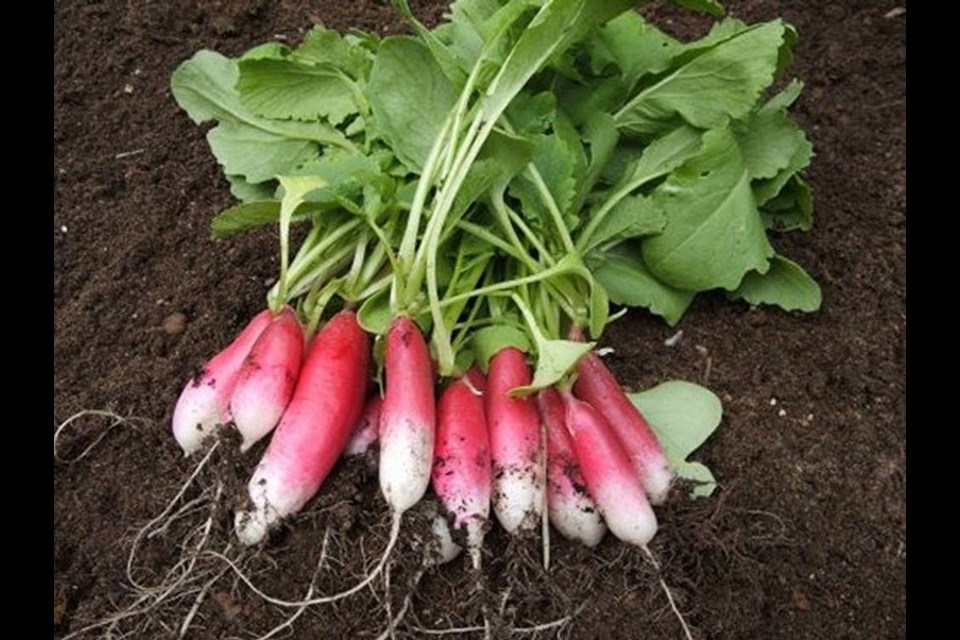Dear Helen: I cannot seem to grow root vegetables successfully. My radishes are all top growth and the carrots take four months to develop a root 2.5 cm long.
C.M.
There are several reasons commonly given for root vegetables to fail in forming usable roots — a soil that is compacted and not loose enough for roots to penetrate; a failure to thin rows of developing young plants and a resulting overcrowding; shade.
That said, in my opinion the usual reason for root development failure is an imbalance among major nutrients in the soil. Too much nitrogen in the soil encourages lush top growth, at the expense of root development. Preparing the soil with a nitrogen-rich compost or using a high-nitrogen fertilizer can cause the imbalance.
Root crops need adequate supplies of phosphorus and potassium, the two other major nutrients needed by plants.
Fertilizers all carry three numbers on the labels. They represent the major nutrients nitrogen (N), phosphorus (P) and potassium (K), in that N-P-K order.
For phosphorus, I use rock phosphate or bone meal. Kelp meal is the source I use for potassium. It also has many trace minerals helpful for plant growth. Or, use ready-mixed fertilizers evenly balanced among the three numbers. In our generally acidic coastal soils lime added to the soil is also helpful.
For a boost to root growth in plantings already underway, a possible treatment is a watering with Alaska Morbloom. It has no nitrogen, just phosphorus and potassium. Its N-P-K ratio is 0-10-10.
Dear Helen: I have a small rooted cutting — just a twig really — of a beauty berry bush. I want to begin pruning it to encourage a nice, full shape. How do I do this?
V.B.
The photo you sent is of a very small plant. It does look, however, substantial enough to plant in a sunny garden site with fertile, well-drained soil. It needs to grow and develop a little before you can begin shaping it. Callicarpa plants grow naturally in a widely rounded shape, with drooping branches.
Because the plants bloom and form berries on new growth, the usual pruning time is in late winter, before new growth begins. On well established plants, the youngest growth, made in the previous year, is shortened and a small portion of the oldest growth is removed to make way for young flowering stems.
Dear Helen: My 30-year old dwarf Anjou pear tree flowers in the spring but produces only up to six pears. It grows between a Flemish Beauty and a Bartlett, which are semi-dwarf pear trees that produce abundantly every year. Have you any suggestions regarding the pollination of the Anjou tree?
P.W.
Pear trees that have open flowers at the same time should be able to pollinate each other. For Anjou, Bartlett is considered a suitable pollinator. Though Anjou is classed as self-fruitful, such trees produce more with a pollinator.
The issue is not likely to be pollination, unless the trees are very far apart. In the limited space of most home gardens this is unlikely and your question does not suggest a great distance between the trees.
Another possible reason for poor productivity lies in the age of the tree. Dwarf and semi-dwarf pear trees usually last in good fruit-bearing conditions for up to 25 years.
Flemish Beauty, another at least partly self-fruitful pear tree, is considered a good pollenizer for Bartlett.
Dahlia tuber sale. Because of COVID concerns, the Victoria Dahlia Society will not have their usual in-person tuber sale. Instead, an email list of members selling dahlia tubers will be released tomorrow (April 1) and posted on the society’s website: . as well as on Instagram and Facebook.
Abkhazi news. Starting tomorrow, the garden and teahouse at Abkhazi Garden, 1964 Fairfield Rd. in Victoria, will be open seven days a week from 11 a.m. to 5 p.m., with sales at the gate of mulch and plants. Admission is by donation. For menus, special events and gift shop details visit.
VHS. The Victoria Horticultural Society is hosting a Zoom meeting on Tuesday. Lynda Dowling from Happy Valley Lavender and Herb Farm will offer a workshop on edible flowers from 6:30 to 7 p.m., followed by a presentation on all things lavender from planting to harvest (7 to 8:30). Non-members can register for only $5.00. To register visit



